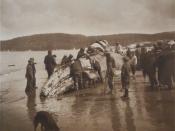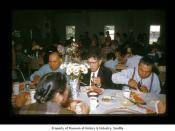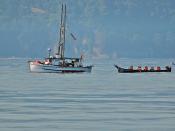The name "Makah", which was given by neighboring tribes, means "Generous with food". The prehistoric Makah Nation had a population of about 4000 people and was composed of five villages. The five villages occupied the shore of the Pacific Ocean and the Strait of Juan de Fuca. The natural resources were abundant with plants and animals. The Makah adapted themselves to their environment, using practically everything they took from the land and sea.
The five villages had massive longhouses, made of large, cedar planks, which housed the Makah and extended families. Their cultural information kept flowing and was pass on by extended families living close together. Some traditional songs, dances, and stories were, and still are today, inherited, and only certain individuals within the Makah family can perform them. At celebrations (called potlatches), such as a wedding and memorials, specific songs are preformed to reaffirm ownership.
Canoes, carves from red cedar, allowed the Makah who were excellent mariners, to navigate the swift waters of the Pacific Ocean and the Strait of Juan de Fuca.
The early Makah carved various types of canoes; war, whaling, halibut, salmon, fishing, sealing, and large cargo canoes.
An epidemic of small pox, tuberculosis, influenza, and whooping cough, along with war, killed many Makah People in the late 1700s. European contact created this devastation a lot of family tradition and knowledge was lost. The Treaty of Neah Bay, between the United States and the Makah Indians, was signed on January 31st, 1855, which protected the Makah's whaling, sealing, fishing and village land rights from being totally eliminated. The Makah had to give up 300,000 acres of tribal land in order to keep some of their ancient culture alive. The Makah population currently is around 2,000, which is half of what is used to be.
In early 1700s, the village of Ozette was buried and preserved under a disastrous mudslide. In 1981, archaeologists excavated over 55,000 ancient Makah artifacts, some of which were beautifully carved house boards, an elaborate whale saddle, baskets, boxes, canoes, and whaling equipment. Human remains were reburied out of respect and cultural beliefs.
Whaling is a tradition and a source of pride among the Makah. Ancient Makah hunted whales for their meat and blubber and used nearly every part of the catch; blubber was processed into oil and the bones were used to make combs, spindle whorls, war clubs, bark pounders, shredders, and jewelry. The latest, successful whale hunt took place May 17,1999, when the Makah landed a gray whale.
Carvings, made mainly of Western Red Cedar, provide a living for many Makah artists today. Masks, earrings, canoes, and totems are marketable. Whaling, sealing, and fishing were and still are, a large part of the livelihood of the Makah.
The Makah's ancient language is taught to preschoolers, dance practices are held and they still go on canoe journeys. They continue to pass down songs old and new to celebrate important events in their lives. The Makah People cling to and try to preserve the ancient heritage as much as possible in the new millennium.


